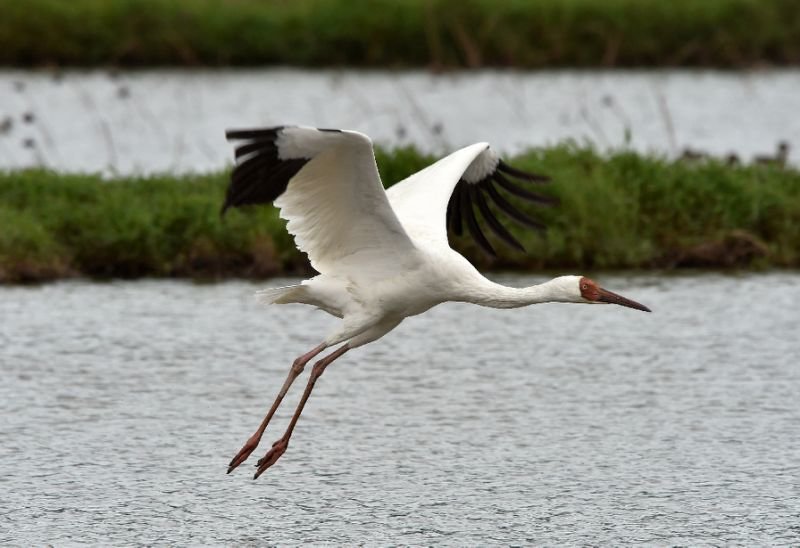Will the lonely Siberian crane ‘Omid’ come back to Iran this year?

TEHRAN — With the onset of the cold season the environment lovers are looking up at the sky anxiously waiting for the last remaining western Siberian crane called ‘Omid’ to come back to his winter home, in Fereydunkenar, northern province of Mazandaran, once again.
Omid (literally meaning hope in Persian), has been winging his way to Iran for years in the first week of the Iranian calendar month of Aban falling on the last week of October, but this year he has not shown up yet.
For the past 7 years the Siberian Crane has been taking a two-month fly of great distance of 5000km from Uvat in western Siberia to Fereydunkenar Damgah [structures built in rice paddies for harvesting wild ducks in autumn and winter by farmers].
Last year Omid flew to Iran 45 days late and left Fereydunkenar earlier than normal ad this made environmentalist worried and now many are still worried whether the eye-catching snow-white bird will come back to Iran or not.
Mazandaran Crane Conservation Association
According to Lisa Pourlak, a PhD student at University of Tehran and member of the International Union for Conservation of Nature (IUCN) Crane Specialist Group, in 1998 a small crane conservation group, the Mazandaran Crane Conservation Association (MCCA), was formed in Iran with the support of Ellen Vuosalo Tavakoli (originally from Finland) who lives in Fereydunkenar and a few Iranian environmental conservationists.
In 2000 this small group grew to include around 200 duck trappers, who joined MCCA by investing in local Trust Funds, which were intended to evolve into a loan program, Pourlak writes.
“This was an important initiative for the conservation of Siberian Crane habitat in Iran, a project that was supported and co-funded by the Small Grants Program of the Global Environment Facility and the United Nations Development Program (2001-2004).
“As a result of this project and through MCCA’s efforts, local trappers became aware of the international importance of Siberian Cranes, and, most importantly, were recognized as “guardians of the cranes” by both Iran’s Department of the Environment and international organizations. Later, this area was listed as an “Indigenous Community Conserved Area” by the International Union for the Conservation of Nature.
“After nearly 15 years local trappers still practice their traditional knowledge in preparing the wetlands and are still playing the role of Omid’s guardians – and that is why the lonely crane has returned for the past seven winters.
“The local trapper associations (now officially registered as local cooperatives) create a safe environment for the crane within their traditional damgahs, or duck-trapping blinds, which are designated No Shooting Areas and a Ramsar Site by the Department of Environment. These magnificent wetlands are in fact becoming one of the few remaining freshwater wetlands in Iran, and are one of the few options remaining in the area for wintering migratory birds in the face of rapid development and climate change.
“The presence of the Siberian Crane each winter has helped protect habitat for millions of other migratory birds, while benefiting local rice farmers, who supplement their winter income with traditional duck trapping.”
Siberian crane
According to the International Crane Foundation website this critically endangered species is now only found in one main population in East Asia, with a few birds remaining in the historic Western/Central population.
The Eastern population breeds in northeastern Siberia and winters at Poyang Lake in the Lower Yangtze River Basin in China. In the Western/Central population, a single crane [Omid] continues to winter along the south coast of the Caspian Sea in Iran. This population bred just south of the Ob River in Russia.
With the height of 140 centimeters and weight of 6 kilograms there are only 3,600 to 4,000 cranes left in the world. The Eastern population is stable, but the Western/Central population almost extirpated.
Adult cranes have red skin on forehead, face and sides of the head, white plumage with black wingtips, and reddish pink legs while juvenile cranes have plumage mix of white and cinnamon-brown feathers and tan head.
The oldest documented crane was a Siberian Crane named Wolf, who died at the age of 83. Wolf is in the Guinness Book of World Records.
Habitat loss, especially due to changing hydrology caused by water diversions and conversion of wetlands, illegal take including hunting, trapping and poisoning, pollution and environmental contamination are threatening this endangered species.
Lisa Pourlak, environmental activist and PhD student at Tehran University, and member of the IUCN Crane Specialist Group.
MQ/MG
Leave a Comment